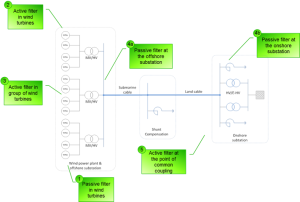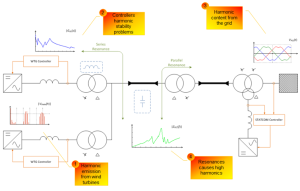Background
Nowadays, it is seen that the rapid transformation of power systems from conventional with high natural damping, short-circuit current and natural inertia to power-electronic-based with limited damping, fault infeed and inertia may trigger unstable operation, if not investigated carefully. Moreover, the electrical infrastructure is becoming more complex due to the introduction of long high voltage alternating current (HVAC) cables, high voltage direct current (HVDC) connections, widespread penetration of renewable energy sources, e.g. photovoltaic (PV) plants, wind power plants (PPs), and offshore electrical network development. This power system transformation creates challenges such as operational coordination of grid-connected converters and small-signal stability assurance both in the sub-synchronous and harmonic (super-synchronous) frequency regions.
Motivation
The increased use of power electronic converters in modern electrical systems creates challenges w.r.t. power system stability assurance but also simultaneously provides wide range of power system performance and stability enhancement solutions. Better understanding about the application of various instability mitigation methods, including impact on power system performance, use depending on instability root cause, implementation methodology, is needed. Power system operators, operators of renewable PPs, transmission solution developers, renewable generation developers, academic units and original equipment manufacturers expect coordinated effort to understand when and how to apply specific mitigation measures.
Therefore, the overview, status and outline of instability mitigation methods in converter-based modern power systems is needed. Thus, the CIGRE C4.49 working group entitled “Multi-frequency stability of
converter-based modern power systems” was established. The instability phenomena, instability root cause and suggests optimal mitigation measures are investigated within the working group. Moreover, guidelines regarding the general approach how to choose optimal instability mitigation method will be suggested in the technical brochure.
Scope
- Review of existing literature regarding subject related stability issues including state-of-the-art converter stability aspects.
- Definition of stability phenomenon to be covered within the technical brochure.
- Stability effects above the fundamental frequency, i.e. harmonic stability.
- Small-signal stability below the fundamental frequency, i.e. sub-synchronous stability.
- Clarification of definitions to avoid misinterpretation with steady-state harmonics and classical harmonic propagation analysis.
- Symptoms and root causes of sub-synchronous and harmonic stability phenomenon.
- Examples of sub-synchronous and harmonic stability phenomena observed and their impact on wider power systems.
- The impact of grid-connected converter controllers on sub-synchronous and harmonic stability phenomenon.
- Classification of typical controllers used in modern converters.
- Evaluation of various control loops and techniques and their impact on stability, e.g. voltage control, current control, phase-locked loop.
- Frequency range of interest and controller interactions/couplings.
- Overview of linear modelling and analysis methods to perform small-signal stability studies, e.g.
- Classical control theory approach of linear time-invariant systems, i.e. compensator and plant interactions, and possible general extension to linear time varying systems including e.g. linear time-varying periodic systems.
- Impedance-based stability criterion.
- Advantages and disadvantages of single-input single-output and multiple-input multiple-output representation.
- Relevant stability evaluation methods, e.g. eigenvalue analysis, Nyquist criterion.
- Other analysis techniques.
- Time-domain numerical simulations of linear and non-linear systems.
- Frequency and sequence coupling investigation.
- Stability of non-linear dissipative dynamic systems including e.g. limit cycle and bifurcation theory investigation.
- Description of mitigation methods to overcome sub-synchronous and harmonic stability issues, e. g.
- Clear evaluation criteria and minimal requirements regarding the stability indices, e. g. stability margins, damping.
- Recommendations to address plant resonance profile at early stage during the grid-connected converter controller design.
- Converter coordination guidelines in modern power systems to avoid potential instability, e. g. passivity requirements.
- Mitigation measures incorporated in the grid-connected converter control (e.g. active damping) or within the power system electrical infrastructure (e.g. passive damping), also at later stage of project development or during operation.
- Guidelines on general approach to such studies and the availability as well as choice of tools. Identification of limitations with the available analysis tools and suggestion of possible areas for development.
References
Ł. Kocewiak, R. Blasco‐Giménez, C. Buchhagen, J. B. Kwon, M. Larsson, A. Schwanka Trevisan, Y. Sun, X. Wang, “Instability Mitigation Methods in Modern Converter-based Power Systems,” in Proc. The 20th International Workshop on Large-Scale Integration of Wind Power into Power Systems as well as Transmission Networks for Offshore Wind Farms, Energynautics GmbH, 29-30 September 2021.
Ł. Kocewiak, R. Blasco‐Giménez, C. Buchhagen, J. B. Kwon, Y. Sun, A. Schwanka Trevisan, M. Larsson, X. Wang, “Overview, Status and Outline of Stability Analysis in Converter‐based Power Systems,” in Proc. The 19th International Workshop on Large-Scale Integration of Wind Power into Power Systems as well as Transmission Networks for Offshore Wind Farms, Energynautics GmbH, 11-12 November 2020.


